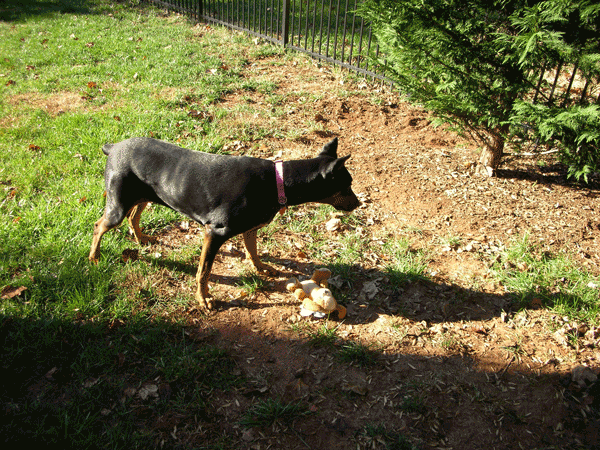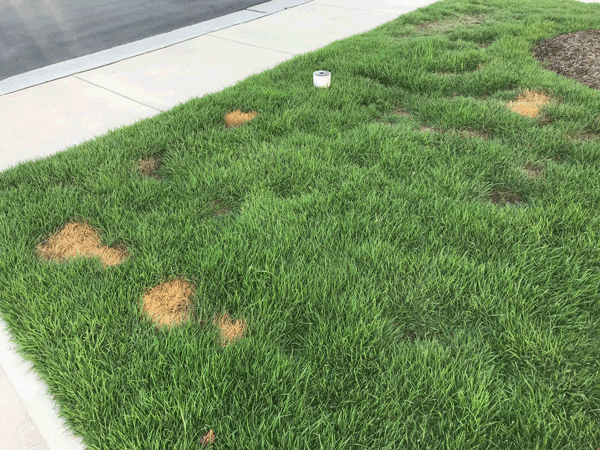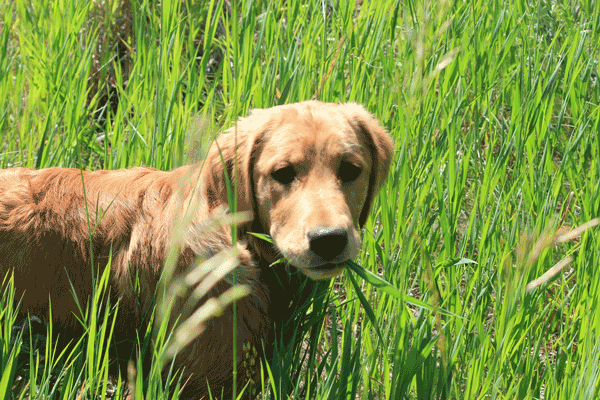Introduction
In the United States in 2020, 63.4 million households had at least one dog, according to the American Pet Products Association. Millions of these dogs find turfgrasses appealing for exercising, as it is a soft surface for running and frolicking. For some dog owners, establishing a tick-free zone is the primary motivation for maintaining a grassy area in which their dog can play and exercise. If mowed regularly, the grass is not likely to harbor many ticks that might find their way onto the pet.
For many dog owners, there is heightened concern about destruction of turfgrass due to heavy dog traffic. As a result, they commonly have questions about selecting the best turfgrass for durability, maintenance, appearance, and vigor. They also often have health-related concerns about dogs related to contact with pesticides or eating of lawn grass (a common occurrence).
Some typical questions are: (1) What are the hardiest turfgrasses to use in high traffic areas? (2) How do you deal with damage known as dog urine patch? (3) What issues are there regarding a dog’s exposure to pesticides? (4) Why do dogs occasionally eat turfgrass, and is it harmful?
Best Turfgrass Choices for High-Traffic Areas
Many dogs are very active when outside, so a turfgrass that can withstand high traffic levels is very important for long-term turfgrass protection. Moderate maintenance of an appropriate turfgrass will accommodate appreciable animal traffic. Bermudagrass is the most traffic-tolerant turfgrass used in North Carolina. It also is very quick to recover from damage. Zoysiagrass is very tolerant of traffic but recovers from damage more slowly than bermudagrass. The problem with using these two warm-season grasses in the landscape is that both types go dormant in the cold season, so they will have dramatically reduced tolerance of wear during the winter. Bermudagrass is also not shade tolerant, so yards with lots of trees will generally not be appropriate for bermudagrass. For this reason, turfgrass selection should be based primarily on the conditions in which the turfgrass will be grown, rather than just the wear-tolerant trait. The NC State Extension publications Carolina Lawns: A Guide to Maintaining Quality Turf in the Landscape and Organic Lawn Care: A Guide to Organic Lawn Maintenance and Pest Management for North Carolina are good resources for selecting the best turfgrass for varying conditions.
If traffic from pets becomes excessive, renovation of the turfgrass may be necessary. Spreading traffic across a large turfgrass area or reducing the time the animal spends on the turfgrass may prevent damage and therefore reduce the need for renovation. It may also be helpful to increase the nitrogen fertility rates (within recommended guidelines) to promote a quicker turfgrass recovery. For turfgrasses that can be seeded, the addition of seeds during the appropriate establishment period may be required to maintain the turfgrass stand. You should temporarily exclude pets from the area during the re-seeding period.
Dogs tend to cause wear on turfgrass in specific areas, often near fences, which provide them good visibility of high-activity areas such as walkways and roads, or other animals (Figure 1).
Dealing With Dog Urine Patch
Damage from dog urine can be mild to severe and detracts from your lawn’s aesthetics for weeks to months. Mild damage appears as taller grass with dark-green spots that disrupt lawn uniformity. At its worst, dead, straw-colored spots about 3 to 6 inches in diameter with dark green perimeters will appear (Figure 2). These spots may be confused with common turfgrass diseases such as dollar spot, brown patch, fairy ring, or spring dead spot. Generally, leaf blades in diseased spots will appear water-soaked and tend to mat down. Disease spots usually lack actively growing darker-green perimeters. It may be helpful to reference the disease pictures at NC State Extension’s TurfFiles to distinguish between potential turfgrass diseases and urine damage. If you are still not sure, you may submit affected turfgrass samples to NC State Extension’s Turf Diagnostics Lab for disease confirmation. Damage from pet urine can open the turfgrass canopy, which encourages weeds, particularly crabgrass, annual bluegrass, and other annual weeds.
Cause of Urine Patch
The major components of dog urine include water, urea, uric acid, lactic acid, creatinine, and bilirubin (Chang, Huang, and Li 2018). Spotting and death of turfgrass are often attributed to the concentrated nitrogen and excess salts in dog urine. The nitrogen will often cause a darker green turfgrass spot. It is a response similar to dropping a handful of concentrated fertilizer on the lawn. The nitrogen concentration of the urine and your lawn’s fertility status will dictate the level of greening response. A well-fertilized lawn is generally less affected by the nitrogen and salts in dog urine.
Although salts in dog urine cause some turfgrass injury, lactic acid has recently been identified as the main culprit for turfgrass death (Chang, Huang, and Li 2018). Lactic acid is a natural byproduct of cellular respiration in dogs. Its concentration in dogs is highly variable and is affected by exercise, diet, and health. Generally, its concentration increases with more physical activity. Lactic acid kills turfgrass by disrupting its cellular membranes and, as a result, its cellular metabolism. This mode of action is similar to some commercial herbicides. Because of lactic acid’s potency, researchers have even evaluated its use as an organic post-emergent herbicide.
Mitigating Urine Damage
The extent of urine damage is influenced by living and nonliving factors. A dog’s breed, sex, and age affect its urination practices and, in turn, urine damage. Although any breed can cause damage, larger dogs excrete higher volumes of urine, thus they tend to cause more severe damage. Damage from female dogs and puppies tends to be more severe compared to mature male dogs. This is because puppies and female dogs tend to squat when urinating, concentrating the urine damage. Male dogs, however, tend to urinate on vertical structures (for example, trees, shrubs, and posts) away from the middle of the lawn. They also are more wayward when urinating and spray larger areas. Therefore, their urine damage typically is less severe.
Soil and weather conditions can also affect the extent of urine damage. Damage tends to be more severe when the soil is dry, when turfgrass is not actively growing, and at higher air temperatures. Dark-green spots from mild damage are more prominent in nitrogen deficient yards.
An obvious and perhaps best solution is to prevent dogs from urinating on your lawn. Train your dog to urinate on mulched areas or at the periphery of the lawn, where damage will be nonexistent or less noticeable. This method can initially require considerable time, patience, and commitment by owners. However, it is the best way to stop urine damage, and the initial time investment will pay long-term dividends. A less practical solution is to water-in dog urine within a few hours of urination with a watering can or water hose. Ideally, urine should be flushed with high volumes of water immediately following urination. Although this limits turfgrass death, it does not reduce the dark-greening of the grass due to the urine.
To minimize damage, you can plant tolerant turfgrass species. Bermudagrass and zoysiagrass are more tolerant of lactic acid compared to cool-season turfgrasses (for example, tall fescue or Kentucky bluegrass) (Li et al. 2019). Tolerance to lactic acid varies among cool-season turfgrass species, with tall fescue being most tolerant, followed by creeping red fescue, then perennial ryegrass, and finally Kentucky bluegrass. There may also be some varietal differences within each species (Li et al. 2019). As with traffic tolerance, climate and shade are factors that should be considered before selecting species for urine tolerance. Regardless of the turfgrass planted, you should use proper mowing, fertility, and irrigation practices to maintain a healthy lawn and minimize damage. Consult Carolina Lawns: A Guide to Maintaining Quality Turf in the Landscape for species-specific recommendations.
Without intervention, unsightly urine spots can linger for weeks to months. Some grasses will naturally recover from severe urine injury; others will require reestablishment. Recovery is mostly dependent upon your turfgrass’s growth habit (spreading or clumping) and growth cycle (warm season or cool season). Turfgrasses that have a spreading growth habit—notably bermudagrass and zoysiagrass—will naturally fill in damaged areas over time. However, tall fescue, for example, has a clumping growth habit, will not naturally fill in dead spots, and must be spot-seeded, plugged, or sodded. If tall fescue damage is excessive, overseeding or total lawn renovation in the fall may be necessary. If you are impatient, dead spots in all turfgrasses may be sodded or plugged. Existing material from the periphery of the lawn may be used when plugging or sodding. If you buy sod for repairs, plant the same cultivar as that of the existing turfgrass. Recovery times depend on the time of year and when turfgrass is actively growing. For warm-season turfgrass, for example, bermudagrass and zoysiagrass, recovery may take as little as a couple of weeks when these grasses are actively growing. Some retail outlets sell kits for repairing damaged spots in a lawn. These often contain a cool-season turfgrass such as ryegrass that will quickly germinate. Note that the grass in these kits will often not match the turfgrass that is in the lawn, especially for warm-season lawns.
Urine Patch Treatment Myths
Attempts to flush or neutralize urine with applications of baking soda or gypsum are not recommended (O’Connor and Koski 2010). Increasing your dog’s water consumption is thought to dilute its urine and decrease turfgrass damage. Though this may be true, these benefits will likely be offset by your dog’s increased frequency of urination. Dietary supplements marketed to diminish urine damage (including Methio-Form, ascorbic acid, fruit juices, baking soda, and potassium citrate) do not have any scientific merit and may negatively affect your dog’s health (O’Connor and Koski 2010). Likewise, attempting to filter impurities from your dog’s drinking water will have little, if any, benefit. When in doubt, consult your veterinarian before adjusting your dog’s diet.
Dog Exposure to Pesticides on Turfgrass
Homeowners may choose to use pesticides to control insects, diseases, weeds, or rodents in the yard. It is important to review the precautionary statements on the pesticide label. This section describes the hazards to humans and domestic animals through exposure. Pesticides may be inadvertently swallowed, inhaled, absorbed through the skin, or sprayed or rubbed in the eyes. The risk to a dog depends on the toxicity of the pesticide, how much pesticide the pet is exposed to, and the duration of exposure. Store pesticides in a secure location, in the original container, and away from your pet’s food and water.
Dog owners can minimize the risk to the dog by following label directions, selecting lower toxicity pesticides, and minimizing the animal’s exposure to the pesticide during and after the application. Be sure to remove the pet’s toys and feeding and watering pans from the area to be treated. Re-entry interval (or REI) will be listed on the pesticide’s label. Most liquid products indicate it is safe for pets to re-enter once the pesticide has dried completely, and this should be assumed to be the minimum requirement if no time is listed. Other products may require keeping pets out of the treated areas for a certain amount of time following application. Outdoor baits for rodents, slugs, and snails can be highly toxic to pets. Precautions should be made so that a pet cannot access locations where these products are applied. If you suspect your pet has been exposed to a pesticide and needs assistance, call your veterinarian.
Dogs Eating Grass
When polled, almost all dog owners have reported their pet eating grass at least once during its lifetime (Figure 3). The consumption of something other than food—known as pica—is a common, normal behavior of domestic dogs regardless of breed or age. This behavior is also prevalent in wild canids (wolves and coyotes). There are several perceived reasons why dogs eat grass: as an indicator of illness, to induce vomiting, to fill a dietary deficiency, to satisfy boredom, to quench their palate, and as a form of herbal self-medication (Sueda, Hart, and Cliff 2008). Some of these theories have scientific merit; others do not.
Indicator of illness/ self-induced vomiting: The long-held belief that dogs eat grass when they feel ill or to induce vomiting has not been supported through research (Sueda, Hart, and Cliff 2008). Instead, researchers concluded that grass eating was a normal behavior, and any ensuing vomiting was incidental (Hart 2008).
Dietary deficiency: Grass eating is not the result of deficiencies in a dog’s diet, and supplementing their diet with plant material does not discourage them from consuming grass (Sueda, Hart, and Cliff 2008). Biologically, dogs may still benefit from eating grass, but these benefits remain largely unknown. It has been proposed that eating grass increases their fiber intake and improves the passage of gas and stool (Sueda, Hart, and Cliff 2008).
Satisfy boredom: Dogs may eat grass as a pastime and to relieve boredom or anxiety. There is an unproven psychological hypothesis that grass consumption tends to increase as owner interaction decreases.
Palate quenching: It has been proposed that dogs may enjoy the taste and texture of turfgrass; however, this has not been proven either.
Self-medication: Eating grass may be a natural deworming method that dogs inherited from wolves (Sueda, Hart, and Cliff 2008). This is supported by the observations that younger dogs usually have a higher frequency of intestinal parasites and eat plants more often. Thus, they may be trying to self-medicate and purge any intestinal parasites.
Summary
The interaction between dogs and turfgrass is natural but may require management to protect the quality of the turfgrass. For success, choose a turfgrass that will grow well in your area and then water, fertilize, mow on schedule, and inspect the turfgrass frequently for wear or other problems. The extra wear from a dog may require additional turfgrass management techniques such as increased fertilizer, core aeration, and renovation practices, or you may need to limit the dog’s time in sensitive areas. If the turfgrass management includes applying pesticides to the turfgrass, be sure to review label recommendations related to human and animal re-entry interval. During their interaction with turfgrass, dogs may eat some of the grasses, but under most conditions this is considered normal behavior and should not cause problems for the dog.
References
Chang, Z., S. Huang, and D. Li. 2018. “Lactic Acid is a Major Contributor to Dog Urine Injury in Cool-season Lawn Species.” Crop Science 58, no. 2: 917–924.
Hart, B.L. 2008. “Why Do Dogs and Cats Eat Grass?” Veterinary Medicine 103, no. 12: 648–649.
Li, D., Z. Chang, C. Wang, and G. Wang. 2019. “Dog Urine Tolerance Among Turfgrass Species and Cultivars Treated with Lactic Acid as Surrogate.” Agronomy. Abstracts. p. 118551.
O’Connor, A.S., and T. Koski. 2010. “Dog Urine Damage on Lawns: Causes, Cures, and Prevention.” CMG Garden Notes #553. Colorado State University Extension Master Gardner Program.
Sueda, K.L.C., B.L. Hart, and K.D. Cliff. 2008. “Characterization of Plant Eating in Dogs.” Applied Animal Behaviour Science 111, nos. 1-2: 120–132.
Publication date: July 21, 2021
AG-905
N.C. Cooperative Extension prohibits discrimination and harassment regardless of age, color, disability, family and marital status, gender identity, national origin, political beliefs, race, religion, sex (including pregnancy), sexual orientation and veteran status.



